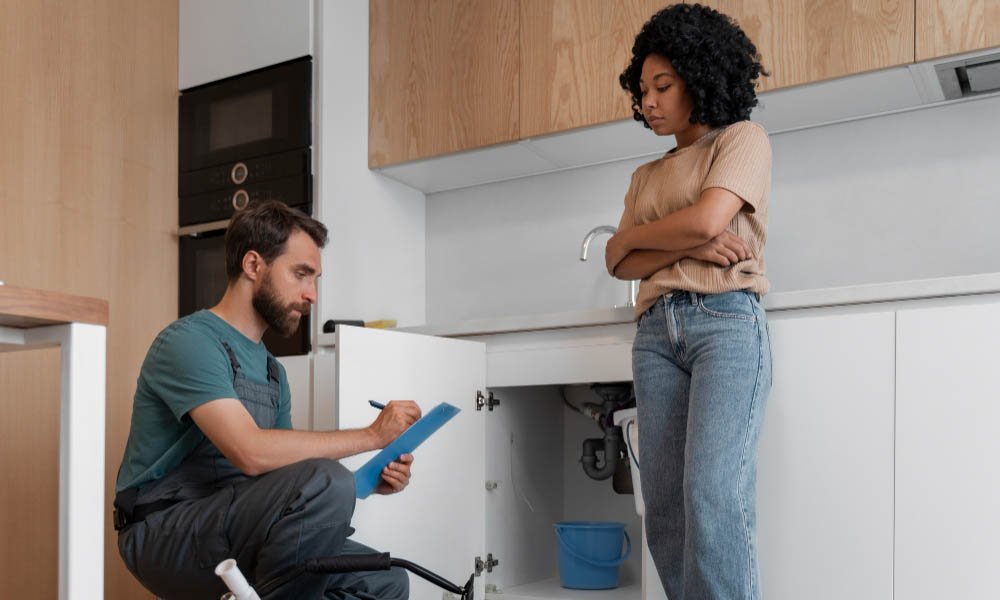Tech
Water Leak Detection Systems: How They Work and Why You Need One
Published
2 months agoon
By
Alexander
If you’ve ever dealt with a surprise water bill, a soaked ceiling, or that musty smell that just won’t go away, you already know—water leaks don’t announce themselves politely. They sneak up slowly, and by the time you notice, the damage is done. That’s why water leak detection systems are becoming one of the smartest upgrades any homeowner can make today.
These systems quietly monitor your plumbing 24/7, spotting leaks long before you do. Whether it’s a burst pipe behind a wall, a slow drip under the sink, or a hidden slab leak, water leak detection systems can alert you instantly—sometimes even shutting off your water automatically to prevent major damage.
In this guide, we’ll break down how water leak detection systems actually work, why they’re so valuable, what types exist, and how to choose the right one for your home.
Why Water Leaks Are Such a Big Deal
Most people underestimate leaks because they start small. A pinhole leak can waste hundreds of gallons in a month. A slab leak can silently destroy floors, cabinets, and foundations. According to the EPA, household leaks waste nearly 1 trillion gallons of water nationwide every year. That’s enough to supply 11 million homes.
But it’s not just about wasted water—it’s about what happens next. Water damage is the number one cause of home insurance claims. Mold growth can start within 48 hours, and structural repairs can easily reach five figures.
That’s where water leak detection systems change the game. Instead of discovering a problem after it ruins your wall or floor, these systems catch it in real time.
How Water Leak Detection Systems Work
The goal is simple: detect water where it shouldn’t be, and stop it fast. But the technology behind it is surprisingly clever.
Let’s look at how these systems function step by step.
1. Constant Monitoring of Water Flow
At the heart of most water leak detection systems is a flow sensor installed on your main water line. It measures how much water is moving through the pipe at any given moment. If the system sees water flowing continuously when no one’s using a faucet or shower, it flags it as abnormal.
For example, if you’re asleep at 2 a.m. but water has been running for 10 minutes, that’s a strong indicator of a leak somewhere in the house.
2. Smart Pattern Recognition
The best systems “learn” your household’s normal patterns—morning showers, dishwashing, laundry—and create a baseline. Over time, they recognize what’s typical for your family. Anything that falls outside those patterns triggers an alert.
3. Immediate Alerts to Your Phone
Once a possible leak is detected, the system sends an instant notification to your smartphone. You can see real-time flow data, get alerts via text or app, and even check how much water you’ve used that day. Some systems send push alerts within seconds, giving you a chance to shut off your water before disaster strikes.
4. Automatic Shutoff Valves
This is where technology really shines. Advanced water leak detection systems come with motorized shutoff valves that automatically close the main line when a major leak is detected. Whether you’re at home or on vacation, your plumbing shuts down before gallons of water escape.
5. Point Sensors for High-Risk Areas
Some systems include small wireless sensors that sit under sinks, near washing machines, or around water heaters. If they detect moisture, they send a signal to the main unit, triggering an alarm or shutoff.
It’s a simple idea—detect, alert, act—but executed with high-tech precision.
Types of Water Leak Detection Systems
There isn’t a one-size-fits-all model. Different homes and budgets call for different approaches. Let’s break down the main types so you can decide what fits best.
1. Passive Leak Detectors
Think of these as the smoke alarms of plumbing. They’re small, battery-powered devices you place near potential trouble spots—under sinks, behind toilets, next to your water heater. When they sense water, they beep or flash.
Pros: Inexpensive and easy to install.
Cons: They only alert you if you’re nearby to hear the alarm. No shutoff feature.
2. Smart Point-of-Use Systems
These add a Wi-Fi connection. When water touches the sensor, it sends a notification to your phone. Great for catching leaks under appliances or in basements while you’re away.
Pros: Instant alerts via phone; no plumbing modification required.
Cons: Limited coverage; doesn’t monitor your main water line.
3. Whole-Home Flow-Based Systems
These are the most advanced water leak detection systems. Installed on your main water line, they continuously track water flow, detect unusual activity, and automatically shut off water when necessary.
Pros: Complete home protection, automatic shutoff, remote monitoring.
Cons: Higher upfront cost and professional installation required.
If you want true peace of mind, this third option is the gold standard.
Key Features to Look For
Not all systems are created equal. When shopping for water leak detection systems, keep an eye out for these important features:
- Automatic Shutoff Valve – Prevents extensive damage by turning off water instantly.
- Smart App Integration – Lets you monitor and control your system remotely.
- Learning Algorithms – Helps the system get smarter about your home’s habits.
- Battery Backup – Keeps protection active during power outages.
- Wi-Fi and Smart Home Compatibility – Works with Alexa, Google Home, or smart thermostats for convenience.
- Local Sensor Support – Add sensors around critical points like water heaters or washing machines.
- Data Reports – Some models show daily, weekly, or monthly water usage to help track conservation.
Real-World Example: The 3 a.m. Pipe Burst
Picture this: you’re out of town for the weekend. A pipe behind your washing machine bursts at 3 a.m. Without a detection system, that leak could pour thousands of gallons into your floor before anyone notices. By Monday morning, you’d be facing warped flooring, mold, and insurance paperwork.
With a water leak detection system, the flow sensor picks up the abnormal surge immediately. You get an alert on your phone within seconds. The automatic valve shuts off your main line. The damage? Maybe a few damp towels—nothing more.
That’s the difference between prevention and disaster.
How Much Do Water Leak Detection Systems Cost?
Here’s the good news: there’s an option for every budget.
- Basic passive sensors: $15–$50 each
- Smart point sensors: $50–$150
- Whole-home smart systems with shutoff valve: $400–$800 (plus professional installation)
While that might sound like a lot upfront, compare it to the average water damage claim of $10,000–$12,000. The system usually pays for itself the first time it prevents a flood.
Installation: DIY or Professional?
Many simple leak detectors are DIY-friendly—just place them and sync to your phone. But if you’re going with a whole-home system, professional water leak detection system installation is usually best. It requires cutting into your main water line, calibrating sensors, and setting up Wi-Fi connectivity.
A pro can also test your system’s shutoff response and make sure it covers every fixture in your home effectively.
Maintenance and Longevity
Water leak detection systems are generally low-maintenance. Still, they do require occasional checks:
- Replace batteries on point sensors annually.
- Make sure Wi-Fi connections stay active.
- Test shutoff valves every few months to confirm they close properly.
- Review usage reports in your app to catch unusual spikes.
With care, most systems last 8–10 years or more.
Environmental and Lifestyle Benefits
Saving water isn’t just about lower bills—it’s about sustainability. The less water wasted, the less energy is used for pumping and heating it. For environmentally conscious families, water leak detection systems complement other eco-friendly upgrades like low-flow fixtures and smart irrigation.
Plus, there’s peace of mind. You can travel, sleep, or even weather a storm knowing your home is being guarded automatically.
Frequently Asked Questions
Will a water leak detection system affect my water pressure?
No. Flow-based systems are designed to maintain normal pressure. You won’t notice any difference in daily use.
Do these systems detect leaks in outdoor lines?
Some models can, depending on where they’re installed. Placing the sensor at the home’s main line usually covers both indoor and outdoor use.
What happens during a power outage?
Many systems have battery backups or mechanical valves that still operate during outages. Always check for this feature before buying.
Can I monitor multiple properties?
Yes—most smart apps let you add multiple homes or vacation properties under one account, making it easy to stay in control wherever you are.
Comparing Popular Brands (At a Glance)
While we won’t recommend one specific brand here, here’s what you’ll often find:
| Feature | Basic Sensor | Smart Point Detector | Whole-Home Flow System |
| Detects leaks | Yes | Yes | Yes |
| Alerts phone | No | Yes | Yes |
| Automatic shutoff | No | No | Yes |
| Installation | DIY | DIY | Professional |
| Price range | Low | Moderate | Higher |
| Ideal for | Apartments or small spaces | Bathrooms, kitchens | Full-home protection |
Who Needs a Water Leak Detection System Most?
While every homeowner can benefit, it’s especially crucial if you:
- Travel frequently or have a second home.
- Own an older property with aging pipes.
- Have hardwood floors, finished basements, or expensive finishes.
- Live in areas with fluctuating water pressure or history of leaks.
- Want to lower insurance premiums—some providers offer discounts for monitored systems.
If you check even one of those boxes, it’s worth the investment.
Final Thoughts: Prevention Is Always Cheaper Than Repair
At the end of the day, water damage isn’t just an inconvenience—it’s one of the costliest problems homeowners face. Water leak detection systems give you something simple but powerful: control. Instead of reacting to a disaster, you’re preventing one.
They blend technology, practicality, and peace of mind into one upgrade that quietly works in the background—protecting your home, your wallet, and your sanity.
Because in modern homes, smart doesn’t just mean convenient. It means prepared.
You may like


Why Did Apple Pull Advanced Data Protection in the UK: What’s Actually Going On?

Study Smarter: How Next-Generation Online Education Delivers Real-World Results

Top 5 Market Research Firms in the UK

The Impact of AI on Modern Financial Decision-Making

How Students Can Stay Connected During Study Abroad and Gap Year Adventures

Bridging the Gap Between Innovation and Real-World Project Delivery

Silent Engines of Industry: The Lifeblood Behind Every Machine

Upgrade Your Bedroom with Custom Wardrobes Made for You

A Winter Market Snapshot: Sittingbourne Buyer Demand and Pricing Trends

Graffitifun graffiti workshops: creative teambuilding and outings redefined

Carol Kirkwood’s Journey: Her Real Age, Husband, Career, and More

Revolutionizing Healthcare: The Emergence of AI-Driven Analytics

How Machine Learning and AI are Redefining the Future?

Aliza Barber: Meet Lance Barber’s Wife, Age, Life, Profile, Career and Net Worth

Evelyn Melendez: Jordan Knight’s Wife Bio, Marriage, Family, Career and Net Worth

Ilan Tobianah Biography: Family, Marriage, Lifestyle, Career and Net Worth

Who was Alice Marrow? Everything to Know About Ice-T’s and His Mother

King Von’s Autopsy Report: The Truth Behind the Tragic Death

Meet Otelia Cox: The Supportive Wife of Tony Cox – A True Fairy Tale Romance

Tea Leoni and Tim Daly Split – A Closer Look at Their Relationship and Breakup

Why Did Apple Pull Advanced Data Protection in the UK: What’s Actually Going On?

Study Smarter: How Next-Generation Online Education Delivers Real-World Results

Top 5 Market Research Firms in the UK

The Impact of AI on Modern Financial Decision-Making

How Students Can Stay Connected During Study Abroad and Gap Year Adventures

Bridging the Gap Between Innovation and Real-World Project Delivery

Silent Engines of Industry: The Lifeblood Behind Every Machine

Upgrade Your Bedroom with Custom Wardrobes Made for You

A Winter Market Snapshot: Sittingbourne Buyer Demand and Pricing Trends

Graffitifun graffiti workshops: creative teambuilding and outings redefined
Category
Trending
-

 News3 months ago
News3 months agoCarol Kirkwood’s Journey: Her Real Age, Husband, Career, and More
-

 Health2 years ago
Health2 years agoRevolutionizing Healthcare: The Emergence of AI-Driven Analytics
-

 Technology2 years ago
Technology2 years agoHow Machine Learning and AI are Redefining the Future?
-

 Celebrity2 years ago
Celebrity2 years agoAliza Barber: Meet Lance Barber’s Wife, Age, Life, Profile, Career and Net Worth
